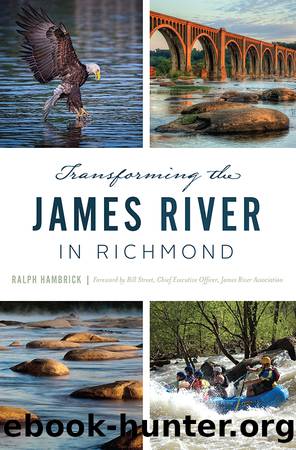Transforming the James River in Richmond by Hambrick Ralph;Street CEO James River Association Bill;

Author:Hambrick, Ralph;Street CEO James River Association, Bill;
Language: eng
Format: epub
Publisher: Arcadia Publishing Inc.
Published: 2020-08-15T00:00:00+00:00
The establishment of the James River Park, largely on land that had seen no development, provided an inviting venue for the rapid growth of recreation on and along the river. Some visionaries had big ideas about the recreational and commercial potential for an area that had been developed and redeveloped many timesâthe downtown riverfront.
7
RIVERFRONT
A VISION THAT LINKS THE FUTURE TO THE PAST
Today the James is a âdiamond in the roughâ begging to be polished as Richmondâs showpiece.
âRichmond and the James, City of Richmond Planning Commission, 1967
At some pointâwho knows when?âRichmond remembered the value of the jewel in its midst.â¦Great accomplishments depend on a vision. And the vision of a Richmond centered on the James pleases the eye and invigorates the spirit.
âRichmond Times-Dispatch editorial, July 26, 1996
Despite pollution and the historical clutter along its banks, the potential for making the downtown riverfront something special had been recognized for decades. Beginning shortly after mid-century, various organizations and individuals began to build a vision of what the downtown riverfront could be. Some of these efforts were officially requested plans; others were unofficial discussions and writing, some preserved and some not. Several newspapers, including the Richmond News Leader, the Richmond Times-Dispatch, Style Weekly, Metropolitan Observer and the short-lived City Edition participated in these periodic discussions. Many early visions of what the river might be were not implemented immediately, or not at all, but they did begin to shape thinking and attitudes about the river.
The riverfront in the central business district is quite different from the less disturbed reach between Bosherâs Dam and Lee Bridge. The shoreline downtown was highly developed before the modern transformation of the river began after mid-century. Although this shoreline is no longer a candidate for wilderness, it still has pristine islands and some of the best whitewater paddling and fishing anywhere.
The downtown banks of the river have been developed and redeveloped many times. It was here that ships coming upstream were stopped by the âfallsâ and here that waterpower was used to mill flour, make rope, produce iron products and generate electricity. Over time, these activities and structures have been replaced by financial institutions, service industries, restaurants and high-rise residential structures.
During the modern transformation of the river, orienting, or reorienting, the city toward the river has been an overarching and recurring theme. During the time when transportation and water power were vital to the economy, the river was a major focus of attention and economic activity in the city. Afterward, the city largely turned away from the river, considering it an obstacle as much as a resource. As Brenton S. Halsey, a major figure in transforming the downtown riverfront, remarked: âIn the 20th Century, Richmond turned its back on the river and buried its riverfront in dilapidated industry, railroads, highways, and general neglectâexacerbated by frequent flooding.â129 The central theme of plans during the last fifty-plus years, both implicitly and explicitly, has been to undo the period of neglect and again make the river the centerpiece of the cityâa centerpiece with a new purpose.
Download
This site does not store any files on its server. We only index and link to content provided by other sites. Please contact the content providers to delete copyright contents if any and email us, we'll remove relevant links or contents immediately.
Whiskies Galore by Ian Buxton(40532)
Introduction to Aircraft Design (Cambridge Aerospace Series) by John P. Fielding(32349)
Small Unmanned Fixed-wing Aircraft Design by Andrew J. Keane Andras Sobester James P. Scanlan & András Sóbester & James P. Scanlan(32149)
Craft Beer for the Homebrewer by Michael Agnew(17464)
Turbulence by E. J. Noyes(7061)
The Complete Stick Figure Physics Tutorials by Allen Sarah(6650)
Kaplan MCAT General Chemistry Review by Kaplan(6071)
The Thirst by Nesbo Jo(5800)
Bad Blood by John Carreyrou(5784)
Learning SQL by Alan Beaulieu(5428)
Weapons of Math Destruction by Cathy O'Neil(5050)
Man-made Catastrophes and Risk Information Concealment by Dmitry Chernov & Didier Sornette(4751)
iGen by Jean M. Twenge(4708)
Digital Minimalism by Cal Newport;(4575)
Life 3.0: Being Human in the Age of Artificial Intelligence by Tegmark Max(4523)
Audition by Ryu Murakami(4108)
Electronic Devices & Circuits by Jacob Millman & Christos C. Halkias(4050)
1,001 ASVAB Practice Questions For Dummies by Powers Rod(4049)
Pale Blue Dot by Carl Sagan(4018)
